|
Salvador - Brazil |
|
Destinations |
 |
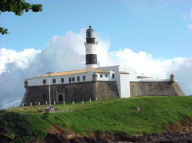 |
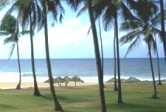 |
|
Due to its unique features, Salvador has become one of
the main international tourist destinations. The capital of Bahia,
famous for its history, the legacy left by people from other
continents, its cultural miscegenation, its religious syncretism and
its hospitable people, has been the setting and object of study of
professionals from diverse areas for many years.
The streets of the Salvador Historical Centre transport the tourist
back to the beginning of Brazil’s history. Tourist guides, avid
students of local culture, explain how the country’s first city was
developed. Up to 1763, Salvador was the capital for the Portuguese
Crown in the Americas, and it also stood out as the main port in the
southern hemisphere until the 19th Century.
The city is considered the country’s cultural capital. It is the
birthplace of many prominent names in the artistic arena, renowned
locally and overseas. Tourism and cultural activity are important
generators of jobs and income, boosting the arts and the preservation
of artistic and cultural heritage. In addition, Salvador boasts many
natural beauties: there are 50 km of coastline and several ecological
parks.
-
Basic information
-
Climate
Salvador is a sunny city, with a hot and humid climate. It is
typically tropical, with an average temperature of 25ºC (76ºF).
-
Events
-
Carnival
Like river rapids, from which no one wants to escape, the ‘trio-elétricos’
sweep up whoever is in Salvador during Carnival. The ‘trio-elétricos’
-- floats with amplifiers used as moving stages -- pass through
three official circuits. Behind them, more than 2 million
merrymakers dance along 25 km of streets and avenues. Osmar’s
float goes from Campo Grande to Castro Alves square, in the town
centre; Dodô’s float, goes from Farol da Barra to Ondina, along
the coast; and Batatinha’s float goes across the Pelourinho.
The first is the oldest circuit. It is also where the event’s most
traditional groups parade. In the Dodô circuit, where the more
famous artists’ box seats are located, the party becomes lively
toward the end of the afternoon, and it continues like this until
morning.
-
City facts
-
Salvador
State: Bahia
Region: Northeast
Population: 2,440,886 inhabitants
Area Code: (71)
Distances
Brasília: 1,540 km
Rio de Janeiro: 1,730 km
São Paulo: 1,960 km
Belo Horizonte: 1,430 km
-
-
Accommodation / Restaurants
-
Salvador’s tourism infrastructure is considered
one of the most complete and most modern in Brazil, especially in
terms of lodging. The city offers accommodations to suit all tastes
and standards, from Youth Hostels to the most sophisticated
international hotels.
The cuisine is an example of the preservation of African cultural
origins in Bahia. Moqueca (fish stew with spicy seasonings) is one
of the local cuisine’s driving forces. There is also bobó de
camarão (shrimp stew), vatapá (seasoned cassava meal mixed with
fish or meat), sarapatel (pig’s or sheep’s viscera and blood)
acarajé (a cake of cooked beans fried in dendê-palm oil) and
sururu broth (edible mussel) or lambreta (steamed clams). The pepper
sauce, always very hot, is served on the side.
The tourist can also opt for other cuisines: Salvador offers many
national and international culinary options.
-
-
How to get there
-
By Air: All Brazilian airlines have daily flights to
Salvador, departing from any capital. There are 30 weekly flights
coming from 18 different cities, located in 13 countries and three
continents.
By Highway: The BR 101 and BR 116 federal highways cross Bahia from
north to south, connecting Salvador to the rest of the country. At
the Feira de Santana junction, take the BR 324 state highway. The
capital of Bahia is served by several coach companies from almost
every Brazilian state.
By Sea: Dozens of cruise ships stop in Salvador, especially during
summer.
-
-
Services
-
Deputado Luís Eduardo Magalhães International
Airport in Salvador
Address: Praça Gago Coutinho, s/nº
Phone: +55 (71) 204-1323 / 204-1244 / 204-1444
Coach Station
Address: Av. ACM, 4362 - Pituba
Phone: +55 (71) 450-4488
Bank Branches
-
-
Attractions
-
Historical Centre
The Salvador Historical Centre, which was declared a World
Heritage site by UNESCO, has thousands of 16th, 17th, 18th, and 19th
Century houses. It is divided into three main areas: the Municipal
Square on the Largo de São Francisco, the Pelourinho and the Largo
do Carmo, ending at the Largo de Santo Antonio Além do Carmo. There
are secular churches and houses, surrounded by rich locally
developed cultural activity. In addition, its steep pavements and
streets paved with ‘cabeça-de-negro’ stones register important
episodes of Brazilian history.
Among its attractions, those deserving of special attention include
the Municipal Square and Sé Square, Lacerda Elevator, City Hall,
the Municipal Plaza, Rio Branco Palace, Misericordia Hospital and
Church, the Archepiscopate Palace, Basilica Cathedral, the Terreiro
de Jesus, Largo do Cruzeiro de São Francisco, Pelourinho with its
churches, shops and squares, and last but not least, Largo do Carmo,
where the Santo Antonio Fort and the great religious complex formed
by the Church and Convent of Our Lady of Carmo and the Church of the
Third Order of Carmo are located.
Popular Manifestations
Passed on from generation to generation, the popular
manifestations are a strong cultural trait of Salvador. City
folklore gathers artistic elements made by the people for the
people, always emphasizing the traditional character of these
performances, such as: capoeira, afoxé, Folia de Reis, Maculelê
and Samba de Roda.
Beaches
The Salvador coastline is one of the longest in Brazil. There
are 50 km of beaches distributed between the High City and the Low
City, from Inema, in the railroad suburb to the Praia do Flamengo,
on the other side of town. While the Low City beaches are bordered
by the waters of the All Saints Bay – the country’s most
extensive bay, with 1,052 km of reflecting waters – the High City
beaches, from Farol da Barra to Flamengo, are bordered by the
Atlantic Ocean. The exception is Porto da Barra, the only High City
beach located in the All Saints Bay.
The capital’s beaches boast enormous ecological diversity because
of this difference. There are calm inlets, ideal for swimming,
sailing, diving and underwater fishing, as well as open sea inlets
with strong waves, sought by surfers. There are also beaches
surrounded by reefs, forming natural pools of stone, ideal for
children.
Churches
Church of Ajuda
Founded in the 16th century by the Jesuits who arrived with Tomé
de Souza. In the 20th century, it was demolished and rebuilt on the
other side of the road. It is one of the oldest churches in
Salvador. Today, the façade has been re-done in a neo-romantic
style.
Church of the Lord’s Ascension
This church, built in 1975, does not follow the conventional
standards of Salvador’s churches. Almost everything in it is
related to the number 12. In homage of Christ’s 12 apostles, the
ceiling is formed of 12 concrete “petals” and 12 pews are
positioned in a row. In the basement there is a mini church, where
the baptistery and sacristy are located.
Church of the Third Order of Saint Domingos
It was started in 1731 and finished six years later. It has a
rococo style façade and neoclassic engraving. Its floor plan is
typical of 18th century churches, with aisles along the sides and a
raised pulpit. The nave’s ceiling has an illusionist concept and
the Noble Room panels are attributed to José Joaquim da Rocha. The
tiles in the Main Chapel are paintings of Saint Domingos.
Our Lady of Penha Chapel
Located in the Iguape Estuary, the main chapel and church nave
are totally covered with “massaroca” type tiles. It is dated
from the mid-17th century.
Priests House – Itacaré
It was constructed by the Jesuits, over a high basement, at the
beginning of the 18th century. The roof has four slopes, with
‘beira-saveiro’ trimming. The house is in a semi-ruined state
and its roof has collapsed.
Basilica Cathedral
It was built in the 17th century with materials such as gold,
marble, rosewood, and turtle ivory. It is a church that blends
baroque and rococo styles.
Church of Our Lord of Bonfim
It was built on the top of a hill in the mid-18th century. The
highlight is the image of Our Lord of Bonfim on an ebony cross,
adorned with silver, greatly adored by the people of Bahia.
Saint Francis Church and Convent
This church is one of the greatest expressions of baroque in
Brazil, having retables decorated with gold. The Saint Peter of Alcântara
image is a work by Manoel Inácio da Costa. Church construction
began in the first half of the 18th century. The panels, made of
Portuguese tiles, portraying Saint Francis’ birth and his
renunciation of material goods, are also baroque. The central nave,
transversally cut through by a smaller one, represents the Cross of
the Lord. The paintings are star-shaped, hexagons and octagons and
exalt Our Lady. In the sacristy, there are 18 oil paintings telling
the story of Saint Francis.
Forts
Santo Antonio da Barra Fort
This fort belongs to the Brazilian Navy and is located at the
northern entrance of the All Saints Bay. It was started by the first
donee of the Bahia Province, Francisco Pereira Coutinho, in 1536,
and it was originally shaped as a ten-sided tower.
Mont Serrat Fort
Due to its elegant shape it is considered the most beautiful
military construction of the Brazilian colonial period. Construction
started in 1583, on a strategic position on top of the most
projecting side of the peninsula, overlooking the city’s port. It
was finished in 1742, and has not undergone any alterations from its
original plan. It still has a command house flanked by round bastion
walls and nine canyons.
Museums
Carlos Costa Pinto Museum
This museum reveals the intimacy of the rich 18th and 19th
century families. Costa Pinto’s private collection originated 23
art décor and painting exhibition rooms. The exhibits includes
collections of silverware, jewellery, Chinese and European
porcelain, crystalware, furniture, paintings, ivory works, opaline,
copper and Chinese lacquer. The gold jewels and the collection with
27 silver trinkets are the most valuable pieces in the entire
collection.
UFBA Sacred Art Museum
It was inaugurated on August 10th, 1959 and is located at the
Santa Tereza Convent, one of the most amazing architectonic
complexes from the XVII century. The work was done by the Carmelitas
Descalças (Barefoot Carmelites). Its collection consists of
sculptures in wood, soapstone, clay and ivory and jewellery. It also
includes a vessel in golden silver, adorned with more than 400 gems
and semi-precious stones.
Bahia Museum of Art
The Bahia Museum of Art is the oldest museum in the State.
Founded in 1918, it operates today from the Solar Cerqueira Lima.
Its collection consists of wood, clay and ivory sculptures, painted
tiles and 17th, 18th, 19th and 20th century silver pieces, as well
as pieces of typical Bahia furniture from the same period.
Abelardo Rodrigues Museum
It harbours one of the largest private collections of sacred art
in Brazil: 808 pieces consisting of images, paintings, oratories,
altars, as well crosses from the 17th to 19th centuries. It is
located at the Solar Ferrão, a valuable building from the civil
architecture of the colonial period.
Shopping
Arts and Crafts
The simplest arts and crafts use natural resources such as
straw, leather, ceramic, wood, seashells and seeds. The most
sophisticated are produced with gems and semi-precious stones. Many
pieces are made in metal such as gold, silver, copper and brass. The
artisans in general opt for religion as a theme for their works,
expressed in images of catholic saints as well as candomblé. The
amulets, which reveal the syncretism of its people, are explored
through figas (an amulet in the shape of a clenched fist with the
thumb clasped between the fore and middle fingers), bull’s-eye,
garlic, four-leafed clover, the famous Bonfim ribbon, among others.
Nature, reflecting the local fauna and flora, is also depicted on
these pieces. The music is represented by atabaques, pau-de-chuva
and water drums, in addition to the famous berimbau and many others
unusual instruments.
Shopping: Suggestions of the best known shops:
Souvernirs and arts and crafts: Mauá Institute - Largo do Porto da
Barra, 2 (Porto da Barra), Rua Gregório de Mattos, 27 (Pelourinho),
and Mercado Modelo - Praça Visconde De Cairu (Lower City - Cidade
Baixa).
Professional berimbaus and atabaques: Mestre Lua - Rua Frei Vicente,
19 (Pelourinho), Mestre Olavo da Paixão – at the stall facing the
Mercado Modelo.
Antiques: Casa Moreira - Ladeira da Praça, 1 (town centre), Rua Rui
Barbosa, 51 (town centre) and Casa San Martin - Rua Rui Barbosa, 69
(town centre).
São Felix and Cachoeira Cigars: Rosa do Prado Tobacco Shop - Rua Inácio
Acciole, 5 (Pelourinho).
Information provided by
Embratur
 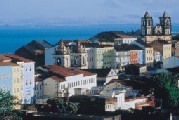 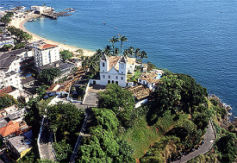 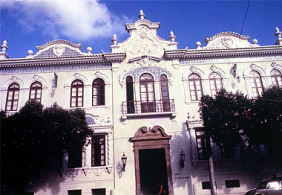   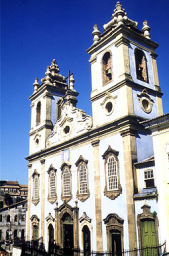
|
|